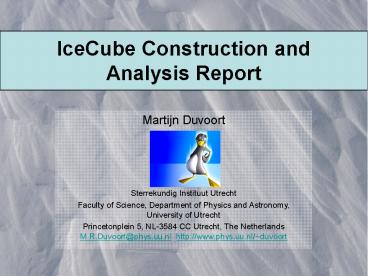IceCube Construction and Analysis Report - PowerPoint PPT Presentation
Title:
IceCube Construction and Analysis Report
Description:
IceCube Construction and. Analysis Report. Martijn Duvoort. Sterrekundig Instituut Utrecht. Faculty of Science, Department of Physics and Astronomy, University of ... – PowerPoint PPT presentation
Number of Views:82
Avg rating:3.0/5.0
Title: IceCube Construction and Analysis Report
1
IceCube Construction and Analysis Report
- Martijn Duvoort
- Sterrekundig Instituut Utrecht
- Faculty of Science, Department of Physics and
Astronomy, University of Utrecht - Princetonplein 5, NL-3584 CC Utrecht, The
Netherlands M.R.Duvoort_at_phys.uu.nl
http//www.phys.uu.nl/duvoort
2
Neutrino Astronomy
Cosmic accelerator
1 pc 3 ly 1018 cm
3
Introducing IceCube
4
IceCube
IceTop
total of 40 Strings IceCube 0.5 km3 AMANDA
0.016 km3
Air shower detetor threshold 300 TeV
InIce
first data 2005 upgoing muon 18. Juli 2005
70-80 Strings , 60 Optical Modules 17 m between
Modules 125 m between Strings
AMANDA 19 Strings 677 Modules
Three more deployment seasons to finish in 2011
5
IceCube 40
- First km-scale detector
- 31 times AMANDA
- Fully digital waveforms
- In-ice timing calibration
- 0.5 - 1 degree resolution
- (depending on track length)
- Data since March 2008
6
(No Transcript)
7
IC22 Events
( Red hits early yellow/green/blue later )
IceCube DOM locations blue, AMANDA OM locations
red
Downward cosmic-ray event (muon bundle)
Upward candidate n event
8
IceCube extensions Deep Core
- IceCube DOM technology
- AMANDA has no veto coverage from top, (which is
where the muons come from) - Ice below 2100m is exceptionally clear,
significantly better even than current ice model.
- Swedish proposal funded by Wallenberg Foundation
9
Current GRB analyses
- ? - ? coincident analysis per GRB
- Fails in case of time difference
- Rolling time window
- Needs GRB with multiple ? detections
- Only 1 10 of GRBs will induce signal ?
- Halzen Hooper 1999, Astrophys. J. 527 (1999)
L93 - Need new method
- Should cope with time difference
- Should allow for cumulative statistics
10
Stacking
? data
Need to cut the background!
11
Stacking around the GRB
- Bkg suppression by GRB location
- 5 deg area around GRB position
- 0.5 1 deg resolution ? cut bkg keep signal
- Used 100 GRBs
- background determination ? off-time sample
Signal Background
On-source
Background
Off-time
12
Sensitivity of our method
- Parameters determining sensitivity
- Number of bursts in sample
- Fraction f of GRBs which yield a signal ?
- Detection in case of 5 s effect
- Minimal f as function of GRBs for detection
- Swift and GLAST nicely coincide with IceCube
13
Conclusion
Astropart. Phys 28 (2008) 540
f the fraction of GRBs inducing a signal ?
- 1 km3 ? detector discovery in coming year(s)
14
Current Status
- Data reconstruction
- 4 years of full AMANDA data
- 2 years of IceCube data
- Off-time bkg determination in process
- (blind) sample used to settle final analysis cuts
- Unblinding proposal expected this spring
- Run final analysis on unblinded sample































